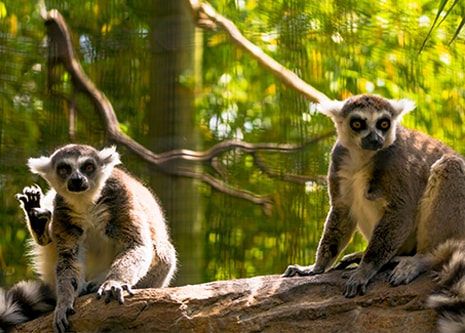
- VisitSupport Happy HollowDONATE TODAYExploreSupport Happy HollowDONATE TODAYLearnSupport Happy HollowDONATE TODAYSupport
-
Today's Hours: 10:00 am to 5:00 pm
Zoo in the HollowCollared peccary

Scientific name: Pecari tajacu
Family: Tayassuidae
Order: Artiodactyla
Class: Mammalia
Range: Southern United States to Argentina, Trinidad, and Cuba
Habitat: Desert, grassland, shrubland, subtropical and tropical forest
Lifespan: 10 to 12 years in the wild; up to 24 years in captivityWhat do they look like?
Adult collared peccaries are around three feet from snout to tail and weigh 30 to 60 pounds, with males being larger than females. They have relatively large heads, small legs, and robust bodies. Peccaries have agouti (alternating dark grey and white bands on a single strand) patterned hair. They have longer hair forming a dorsal ridge that runs the entire length of the body, and a lighter band of hair around their shoulders, which gives them their name.How do they behave?
Collared peccaries are social animals and typically live in groups of six to 12 individuals, led by a dominant male. They eat, sleep and move as a cohesive unit. Herds are kept together by vocalizations and a strong musk smell released from scent glands located on their rump, which is used to mark their territory. They are generally crepuscular, being most active during dawn and dusk. To keep cool during midday, these animals can be found resting in shallow depressions dug into the ground at the bases of trees, fallen trunks and other shady places.What do they eat?
Collared peccaries are omnivorous, and their diets are dependant on the region that they inhabit. In drier habitats, their diet mainly consists of roots, grasses, fruits and cacti. They may also eat eggs, insects, worms and small reptiles. In rainforest habitats, they are predominantly frugivorous, eating fruit that falls from trees. Peccaries help control plant populations, such as cacti and weeds, throughout their range by eating them. At Happy Hollow, they are fed herbivore chow, fruits, vegetables, alfalfa and grass hay.How are they born?
Peccaries can breed year-round, though more young are reared during the rainy season. After a gestation period of 140 to 150 days, female peccaries give birth to one to three reddish-brown young. The young will be weaned after six weeks and stay with the mother for two to three more months. They reach maturity around one year of age, and some young will leave to find a new herd.What should you know about them?
Peccaries and pigs look similar because they fill the same ecological niche, but they live in entirely different parts of the world. True pigs originated in the Old World – warthogs in Africa and wild boars in Eurasia. Peccaries developed in the New World of North and South America. True pigs have long curved teeth that form tusks. Peccaries have enlarged canine teeth, but they are not curved or visible when the animal’s mouth is closed. These dagger-like teeth give them the nickname of javelina, the Spanish word for spear. Peccaries have vestigial tails, three toes on their hind feet, and scent glands whereas pigs have longer tails, four toes on their hind feet, and lack scent glands.Conservation
There are currently three species of peccary and their conservation status ranges from Least Concern (Pecari tajacu) to Endangered (Catagonus wagneri) according to the International Union for Conservation of Nature . All species of peccary are at risk of decline due to increased rates of habitat destruction and overhunting, so it is important that all populations are continually monitored to ensure their success. All three species are listed under the Convention on International Trade in Endangered Species of Wild Fauna and Flora (CITES), which places regulations on the trade and transport of peccary products. If you pledge to stay away from any kind of animal product souvenirs when traveling abroad, you can help the peccaries and save time on your trip back home.
Zoo on the Hill
Located across from the Keep-Around Carousel is the Zoo on the Hill. Learn about wildlife up close during daily meet-and-greets, leap like a lemur on the playground, brush and feed the goats,, or take a peek inside Doc’s Critter Care building and the Ranch House. Double-H Ranch features a combination of animal exhibits, including giant anteaters and red ruffed lemurs, as well chickens and domesticated animals that are docile enough to touch.
See Animals
Education Ambassadors
From camps and classes to scout badges and sleepovers, Happy Hollow education programs have something for everyone! The zoo education program offers a broad range of hands-on, engaging programs and public presentations featuring education ambassador animals. These encounters are designed to connect you to wildlife and the conservation of their habitats around the world.
See AnimalsVisit Us Today
Plan an unforgettable experience at San Jose’s family-friendly park and zoo.
Learn More